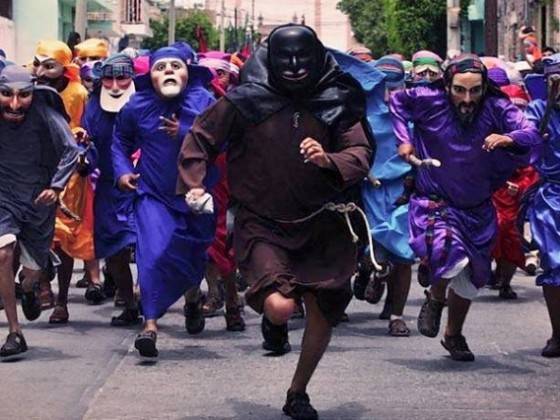

17 Incredible Images of Holy Week in Latin America
2. Penitents are a common sight of Holy Week in Spain, but they’re also present in processions around Latin America.
3. During Holy Week we can witness the strong relationship between Catholicism and Latin American identity. Here, a penitent in Quito is seen praying during a procession.
4. Some penitents submit themselves to physical punishment. Encruzados in Taxco, México, carry heavy loads of prickly rods over their bare shoulders.
5. Talcigüines are red-masked mischievous characters from Texistepeque, El Salvador. Their role is to cleanse sins through whiplashes. They even cleanse tourists’ sins.
Hoy se celebra una gran tradicion en Texistepeque , Los Talciguines , esta vez no tendre la oportunidad de ir, pero invito a todos y todas que vayan , es una tradicion poco comun pero ideal para “pagar por lo pecados cometidos xD” . . #El_Salvador #Talciguines #2015 #Tradicion #Taboo #Texistepeque #red
A photo posted by Edwin Casoverde (@edwincasoverde) on
6. Similar characters roam the streets of San Miguel de los Ranchos in Puebla, México. Xinacates, as they call themselves, take over the small town just before the beginning of Lent.
7. The procession of fire in Goiás, Brazil, gathers thousands of people each Holy Thursday.
8. Alfombras are crafted from sawdust and flowers. These carpets are as iconic of Holy Week in Guatemala as the great processions in Antigua.
A photo posted by Andres Caceros (@andres_caceros) on
9. The neighbours of Iztapalapa, a popular borough in Mexico City, prepare their traditional representation of the Via Crucis for months, or even years, before the celebration. This time they’re expecting almost three million visitors.
10. Judas is a very important character in most Latin American celebrations of Holy Week. These guys from Veracruz, Mexico, depict him in a very colourful way.
Judas patas peludas,que se comen las memelas crudas😂
#Judas #SemanaSanta #Cuitláhuac2016 #TradiciónA photo posted by Rosii MB (@rosamontalvo23) on
11. But Judas is also seen as an advocate of evil and the burning of his image is traditional in some countries like Venezuela and Mexico. Judas figures come in the shape of demons, local politicians and other evil-looking characters.
A photo posted by Montzz (@montzz_loop) on
A photo posted by Montzz (@montzz_loop) on
12. Some traditions are way older than others. The Lord of Tremors procession in Cusco dates back to 1650 and remains as impressive and significant as ever.
#señordelostemblores #cusco #cuzco #peru #southamerica #geocusco
A photo posted by Carlos (@geocusco) on
13. El Arrastre de Caudas is a funeral ritual from ancient Rome. The only place where this celebration can be experienced nowadays is in the Metropolitan Cathedral of Quito and just one time a year during Holy Week.
14. This Equatorian boy demonstrates you’re never too young to wear the purple tunic of cucuruchos.
A photo posted by Jose Pablo Chumil A (@jpchumil) on
15. Being a penitent is not an easy task, it’s a real test of faith.
A photo posted by @olezamat on
16. In Purísima del Rincón, a small town of the Mexican state of Guanajuato, people have performed La Judea for almost 150 years. This popular play puts Judas on the main stage of Semana Santa. A mixture of Catholicism and pagan traditions.
#LaJudea tradición orgullosamente purisimense.
A photo posted by Purisima del Rincon (@purisimadelrincon) on
17. Easter Sunday ends with a bang in Mexico as people light up toritos and castillos, huge structures full of fireworks to celebrate the conquest of evil. 
Carnaval de Tradiciones en el Museo Dolores Olmedo #quemadeJudas
A photo posted by Difundamos México (@difundamos_mexico) on
Carnaval de Tradiciones en el Museo Dolores Olmedo #quemadeJudas
A photo posted by Difundamos México (@difundamos_mexico) on